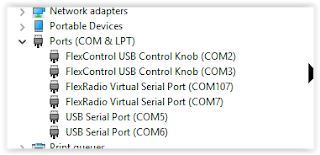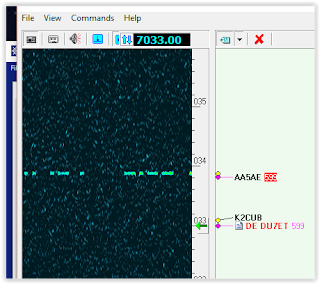The program couldn't be easier to set up. Load, update and set up a couple forms. The program needs a link between the radio and the logger. I had port 7 set up in SCAT so I used that.
On the N1MM+ side
There may be a better way to do this. I didn't read any directions just gave this a try and it worked. Make sure there are no conflicts between ports in device manager
I also set up the focus manager in the radio under Settings>RadioSetup
I couldn't get the N1MM choice to work in the Window dropdown so I filled in Flex-6000 and it worked.
I decided to add a skimmer link to a N1MM band map
This allows skimmer/SDR-Bridge to populate the band map through a Telnet local loop link. Call signs can then be extracted from off the air (no internet) and used to populate N1MM+'s entry window
Here K5TQ is noted on skimmer. I click that and he is transferred to a "pre" QSO state in the logger
If decide to call him, I click his call sign and he is transferred to "ready to log" status.
I copy the exchange and I'm on to the next contact, very effective.
If I get a dupe it lets me know
To set up the skimmer telnet local loop was easy
In the logger screen choose tools>Telnet Window Tools
Which opens
Choose localport as the cluster and edit list
Edit the port number to 7310 and hit OK
Then connect to localport and type in your callsign. Skimmer sends out spots on local port 7310 so the band map should start to populate
I'm sure that just scratches the surface of the feature set of N1MM+. I didn't set up the keyer or macros or messages. I just programmed a couple messages in my keyer and in short order had 100 pts in the log
Mucho Funno
73 W9OY


















